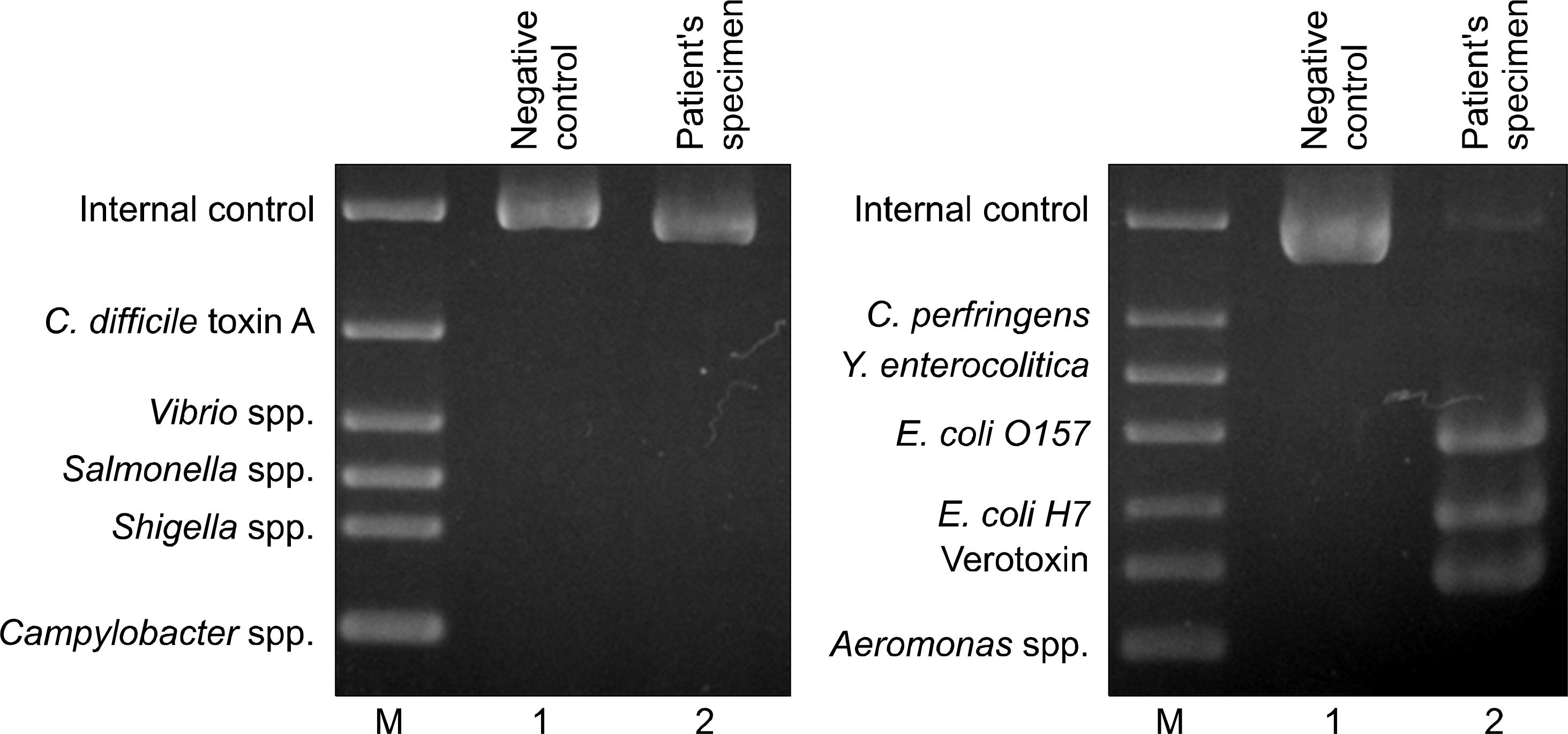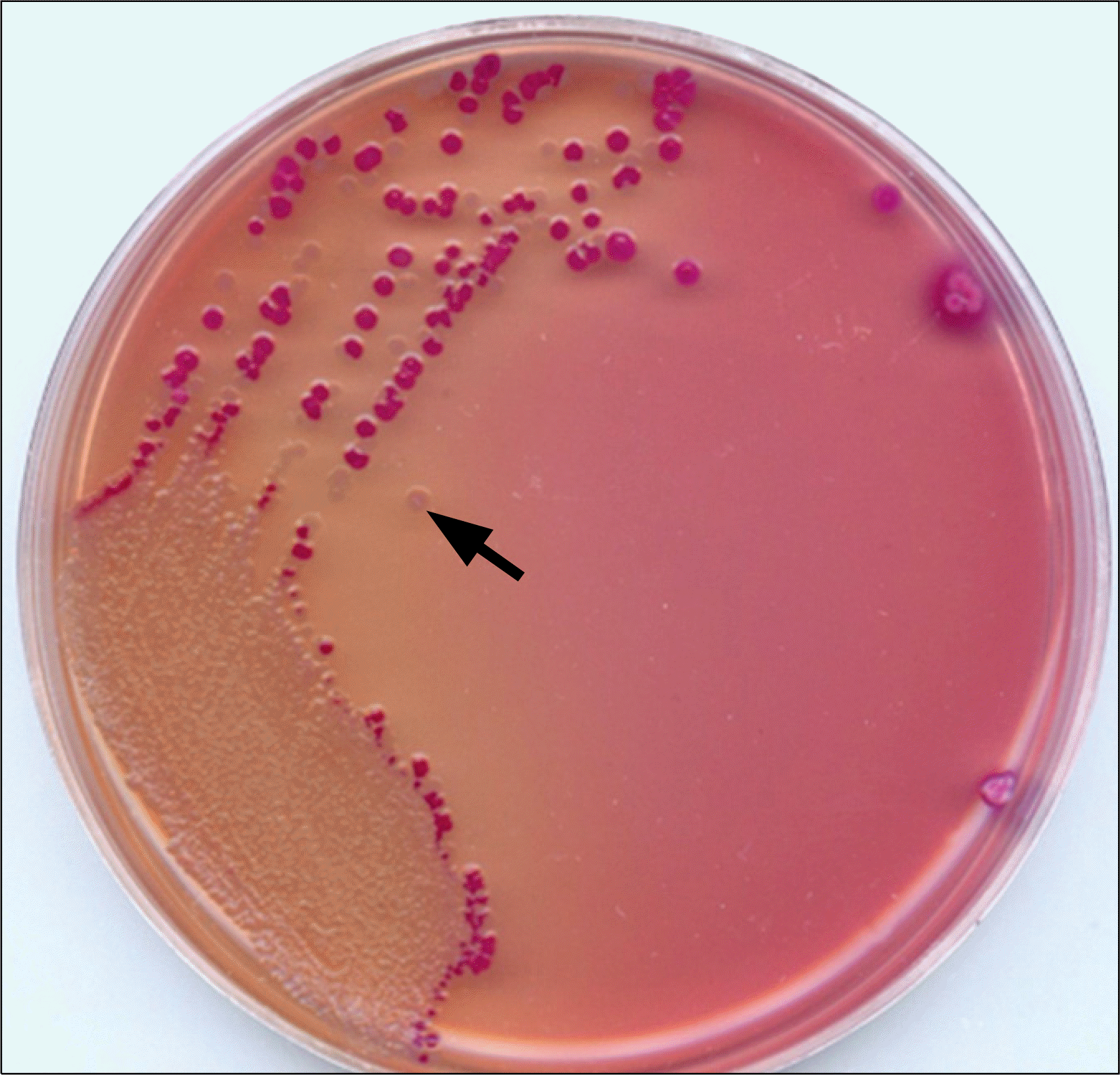Abstract
Enterohemorrhagic Escherichia coli (EHEC) is an important cause of bloody diarrhea in children, but is considered to be rare in infants. Herein, a case of infant hemorrhagic colitis of verotoxin-producing E. coli O157:H7 diagnosed by multiplex PCR is reported. A nine-month-old boy was admitted to our hospital with bloody diarrhea for the previous two days. Multiplex PCR using SeeplexⓇ Diarrhea ACE Detection Kit (Seegene, Seoul, Korea) was directly applied to the stool specimens. Amplified bands specific for verotoxin, O157, and H7 indicated the presence of O157:H7 EHEC. The stool specimens were inoculated on sorbitol-MacConkey agar (SMA) and tryptic soy broth containing mitomycin C (TSB-M). Colorless colonies on sorbitol-MacConkey agar were O157-positive. TSB-M enrichment cultures of the stool specimen and the isolates were positive for verotoxin according to an enzyme immunoassay (EIA). The prepared ingredients of baby foods for the patient including ground meat, chopped carrot, chopped cabbage, and white rice porridge showed no EHEC on TSB-M and SMA. The patient's parents and three-year-old sister did not recently have any gastrointestinal symptoms. Cefdinir was administered for one day and was ceased after diagnosis of EHEC colitis. The stool culture and verotoxin assay were negative on the second day of hospitalization. Application of multiplex PCR and verotoxin EIA directly to diarrheal stool warrants the rapid diagnosis and appropriate treatment of EHEC colitis.
Go to : 
REFERENCES
1. Nataro JP and Kaper JB. Diarrheagenic Escherichia coli. Clin Microbiol Rev. 1998; 11:142–201.
3. Riley LW, Remis RS, Helgerson SD, McGee HB, Wells JG, Davis BR, et al. Hemorrhagic colitis associated with a rare Escherichia coli serotype. N Engl J Med. 1983; 308:681.
4. Marjut Eklund. Enterohemotthagic Escherichia coli Findings from Humans in Finland. Publications of the National Public Health Institue; A23/2005.
5. Slutsker L, Ries AA, Greene KD, Wells JG, Hutwagner L, Griffin PM. Escherichia coli O157: H7 diarrhea in the United States: clinical and epidemiologic features. Ann Intern Med. 1997; 126:505–13.

6. Espié E, Grimont F, Mariani-Kurkdjian P, Bouvet P, Haeghebaert S, Filliol I, et al. Surveillance of hemolytic uremic syndrome in children less than 15 years of age, a system to monitor O157 and non-O157 Shiga toxin-producing Escherichia coli infections in France, 1996-2006. Pediatr Infect Dis J. 2008; 27:595–601.

7. Tarr PI, Gordon CA, Chandler WL. Shiga-toxin-producing Escherichia coli and haemolytic uraemic syndrome. Lancet. 2005; 365:1073–86.

8. Korea Center For Disease Control and Prevention. Communicable disease monthly report. 1994; 5(12):
9. Korea Center For Diseae Control and Prevention Outbreak of Enterohemorrhagic Escherichia coli in early 2003. Communicable Disease Monthly Report. 2003; 14:389–94.
10. Korea Center For Diseae Control and Prevention Outbreak of Enterohemorrhagic Escherichia coli in early 2004 Communicable Disease Monthly Report. 2004; 15:163–64.
11. Song WK, Kim HT, Lee KM, Cha JK, Lee KH. Isolation of Escherichia coli O157 in children with diarrhea. Korean J Pediatr Infect Dis. 1997; 4:73–7.

12. Hong SY, Hwang JH, Lee HA, Kim YS, Yang DH, Kim HK, et al. A case of Escherichia coli O157: H7 infection in the South of Choongnam province, in Korea. Korean J Nephrol. 1997; 16:558–562.
13. Coia JE. Clinical, microbiological and epidemiological aspects of Escherichia coli O157 infection. FEMS Immunol Med Microbiol. 1998; 20:1–9.

14. Mead PS and Griffin PM. Escherichia coli O157: H7. Lancet. 1998; 352:1207–12.
15. Tilden J Jr, Young W, McNamara AM, Custer C, Boesel B, Lambert-Fair MA, et al. A new route of transmission for Escherichia coli: infection from dry fermented salami. Am J Public Health. 1996; 86:1142–5.

16. Pai CH, Ahmed N, Lior H, Johnson WM, Sims HV, Woods DE. Epidemiology of sporadic diarrhea due to verocytotoxin-producing Escherichia coli: a two-year prospective study. J Infect Dis. 1988; 157:1054–7.

17. Yoon SH, Park IJ, Lee WG. A case of Escherichia coli O157 hemorrhagic colitis. Korean J Clin Microbiol. 2008; 11:66–8.
18. Kim YB and Oh YH. Use of polymerase chain reaction and serum antibodies for diagnosis of enterohemorrhagic Escherichia coli. J Korean Soc Microbiol. 1998; 33:99–110.
19. Paton AW, Paton JC. Detection and characterization of Shiga toxigenic Escherichia coli by using multiplex PCR assays for stx1, stx2, eaeA, enterohemorrhagic E. coli hlyA, rfbO111, and rfbO157. J Clin Microbiol. 1998; 36:598–602.
20. Kim EC, Oh JH, Lee HJ. Detection of Escherichia coli O157: H7 from stool by polymerase chain reaction. Korean J Infect Dis. 1999; 31:420–4.
21. Gómez-Duarte OG, Bai J, Newell E. Detection of Escherichia coli, Salmonella spp., Shigella spp., Yersinia enterocolitica, Vibrio cholerae, and Campylobacter spp. enteropathogens by 3-reaction multiplex polymerase chain reaction. Diagn Microbiol Infect Dis. 2009; 63:1–9.

22. Belongia EA, Osterholm MT, Soler JT, Ammend DA, Braun JE, MacDonald KL. Transmission of Escherichia coli O157: H7 infection in Minnesota child day-care facilities. JAMA. 1993; 269:883–8.
23. Tarr PI, Neill MA, Clausen CR, Watkins SL, Christie DL, Hickman RO. Escherichia coli O157: H7 and the hemolytic uremic syndrome: importance of early cultures in establishing the etiology. J Infect Dis. 1990; 162:553–6.
24. Law D, Ganguli LA, Donohue-Rolfe A, Acheson DW. Detection by ELISA of low numbers of Shiga-like toxin-producing Escherichia coli in mixed cultures after growth in the presence of mitomycin C. J Med Microbiol. 1992; 36:198–202.

25. Beutin L, Steinrück H, Krause G, Steege K, Haby S, Hultsch G, et al. Comparative evaluation of the Ridascreen Verotoxin enzyme immunoassay for detection of Shiga-toxin producing strains of Escherichia coli (STEC) from food and other sources. J Appl Microbiol. 2007; 102:630–9.
26. Hong IH and Koo JH. Clinical Characteristics and prognostic factors of hemolytic uremic syndrome in Korean children. Korean J Nephrol. 2001; 20:486–92.
Go to : 
 | Fig. 1.Two sets of multiplex PCR assay using SeeplexⓇ Diarrhea ACE Detection Kit revealed amplicons specific for O157, H7, and verotoxin. Lane M: Synthetic size markers tailored for this kit. Lane 1: Negative control showed internal control band. Lane 2: PCR of patient's specimen revealed ampicons specific for O157, H7, and verotoxin. |




 PDF
PDF ePub
ePub Citation
Citation Print
Print



 XML Download
XML Download